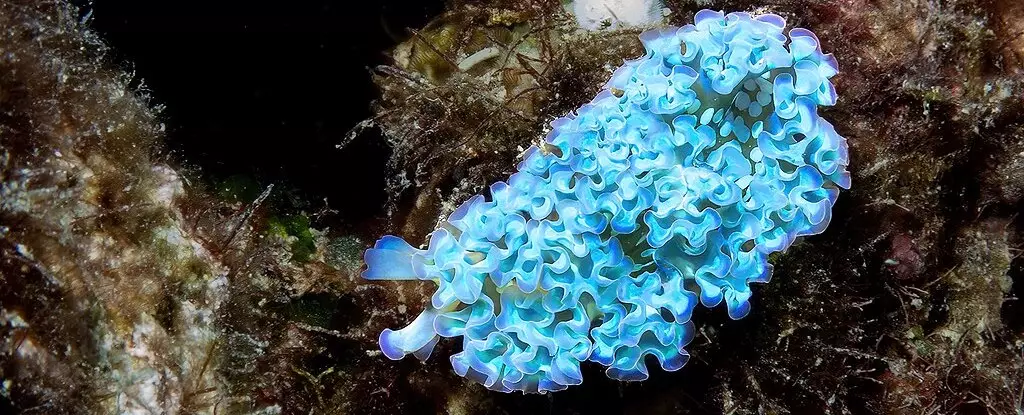Nature often presents us with mechanisms that seem ripped straight from science fiction—unexpected, astonishing, and sometimes disconcerting. One such marvel is the lettuce sea slug (Elysia crispata), an ectothermic organism that defies conventional biological norms by hijacking parts of other organisms to sustain itself. Rather than relying solely on traditional feeding methods, this seemingly innocuous marine creature has developed an extraordinary strategy: it appropriates chloroplasts from ingested algae and repurposes them as solar panels, effectively turning sunlight into sustenance. This breathtaking adaptation challenges our understanding of autonomy in living organisms, raising profound questions about species boundaries, survival strategies, and the ethical implications of such biological “theft.”
The process by which Elysia crispata accomplishes this feat isn’t simply a matter of digestion. Instead, it involves a sophisticated biological hijack. The sea slug captures chloroplasts from algae and sequesters them in specialized vesicles within its gut called ‘kleptosomes.’ These organelles are kept alive and functionally active within the slug’s body, functioning much like embedded solar panels. The chloroplasts even continue producing proteins, adjusting to their new host environment by incorporating slug proteins into their systems. The elegance of this cellular manipulation is both awe-inspiring and unnerving, revealing a form of biological parasitism that blurs the lines between mutualism, symbiosis, and outright theft.
Deception and Adaptation: The Hidden Costs and Ambiguities
While the scientific community has long observed the phenomenon of chloroplast stealing, the underlying biology has remained elusive until recent studies. Harvard researchers unveiled that the chloroplasts are not digested like regular food but are instead preserved in a state of functional dormancy, allowing the slug to harness sunlight for energy. This not only prolongs their survival but transforms the slug into a miniature solar-powered organism, capable of sustaining itself with minimal feeding. The implications are staggering: evolution’s capacity for innovation seems to have no bounds, even allowing an animal to essentially “pirate” parts of another species’ cellular machinery.
However, this process raises dark questions about survival ethics within the natural world. The sea slug’s capacity to exploit the chloroplasts demonstrates an invasive approach to resource acquisition—absorbing and repurposing elements of other organisms for its own benefit. Is this merely an example of nature’s ingenuity, or a reflection of broader themes of exploitation that echo human concerns? To what extent does such biological theft challenge our moral perception of the environment, especially when organisms evolve mechanisms that bypass the classic predator-prey dynamics?
Moreover, the reliance on stolen chloroplasts appears to be a temporary fix rather than a sustainable strategy. When deprived of adequate algae, the slugs revert to consuming more traditional food sources or turn color—orange instead of green—possibly indicating stress or depletion of their chloroplast reserves. This raises alarms about the limits of such an adaptation and whether it offers a true evolutionary advantage or a fragile workaround prone to collapse under environmental pressures. The potential over-reliance on such stolen organelles suggests a vulnerability that could threaten the species as climates shift and food sources become scarcer.
Broader Implications for Humanity and Ethics
The study of Elysia crispata’s remarkable mimicry of solar energy harnessing touches on fundamental themes relevant to human society. Our own biological history hints at a similar narrative—mitochondria, the powerhouse organelles within our cells, are believed to have been once independent bacteria absorbed into early eukaryotic cells through endosymbiosis. This raises the unsettling yet fascinating possibility that life forms can acquire capabilities from their environment through processes that resemble theft at a cellular level.
For human society, this biological phenomenon prompts a reflection on how we approach innovation and resourcefulness. Are we, in our own way, engaging in similar forms of selective absorption—integrating external tools, technologies, and even ideas—into our biological and cultural fabric? The difference lies in the morality of the act. While nature’s “theft” seems driven solely by survival, humans wield such capacities with ethical considerations, regulation, and consciousness.
Yet, the boundaries remain blurred. As biotechnology advances, we risk crossing the line into creating organisms or systems manipulated at a cellular level, mimicking the sea slug’s silent theft. This challenges us to consider the moral dimensions of such interventions. Do we have the right to manipulate lifeforms in pursuit of energy efficiency, longevity, or even aesthetic enhancement? The creature’s ability to steal and sustain life components compels us to reflect on what it truly means to innovate ethically.
In the end, the lettuce sea slug exemplifies both the ingenuity and the peril of biological borrowing. It highlights nature’s relentless drive to adapt through unconventional means—sometimes at the expense of others—and forces us to confront the ethical gray areas that arise when we mirror these practices in our own technological evolution.


Leave a Reply